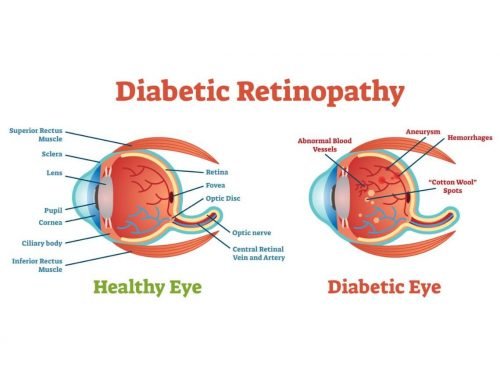Understanding diabetes-related eye disease – Diabetic Retinopathy
Diabetes can manifest itself through several ophthalmic conditions.
Diabetic retinopathy (DR) is the most prevalent and is characterised by damage to the retinal blood vessels due to chronically high glucose levels and can lead to blindness. Detection at an early stage would help in preventing permanent vision loss.
SYMPTOMS
DR is the most common cause of blindness in the working-age population worldwide. Many patients will remain asymptomatic, even in the presence of proliferative disease. Most patients will only present after developing severe disease.
Symptoms of diabetic retinopathy include:
- Floaters
- Blurred vision/ distortion
- Sudden loss of vision
- Blindness: if left untreated
Investigations
HbA1c: to assess how well or poorly a patient’s diabetes is being controlled.
- Optical coherence tomography (OCT)
- OCT imaging provides a cross-sectional view of the retina.
- Used when examining diabetic macular oedema to help quantify levels of oedema and retinal thickness in and around the macula.
- Fluorescein angiography (FA)
- It is used in DR for clearer identification of signs that may be difficult to see with clinical examination alone (e.g., retinal ischaemia and identifying microvasculature). FA can also highlight other retinal features like microaneurysms and dot/blot haemorrhages.
Screening
- An annual eye screening for any individual over the age of 12 with diabetes.
- The screening program aims to promptly identify and manage any changes associated with diabetic retinopathy.
Those with proliferative DR that undergo treatment can reduce their risk of severe vision loss by 50%.
Many patients with DR will have little/no symptoms with DR and therefore require minimal intervention.
Medical management
Good Glycaemic control (hba1c <7) delays the progression of DR.
Blood pressure control:
Diet, exercise and smoking cessation
Photocoagulation(LASER)
SLOWING THE PROGRESSION OF THE DISEASE
Photocoagulation is the primary intervention in the management of proliferative DR .
TYPES
- Focal photocoagulation (FP)
- Pan-retinal photocoagulation (PRP)
Intravitreal anti-VEGF injections
Anti-VEGF injections focus on minimising neovascularization. Aflibercept (Eylea) and Ranibizumab (Lucentis) are two commonly used anti-VEGF agents in the treatment of DR.
Vitrectomy
In persistent vitreous haemorrhage or in central, sight-threatening tractional retinal detachment, a vitrectomy may be performed.
We are the Best super specialty Eye Hospital in Pune – Vision Next Foundation Eye Hospital,
S No. 42/1,2,3, Plot B, Shantiniketan Path, Off, Bhau Patil Rd, near PUNE IT PARK, Bopodi, Pune, Maharashtra 411020e
We are equipped with the world’s most advanced techniques for Cataract, and Lasik glaucoma treatments. Ultramodern diagnostic services for Retina, Glaucoma, Squint, Cornea treatments, and Oculoplasty.
For more info visit us at https://visionnextfoundation.com/
– Dr. Neha Kathuria

